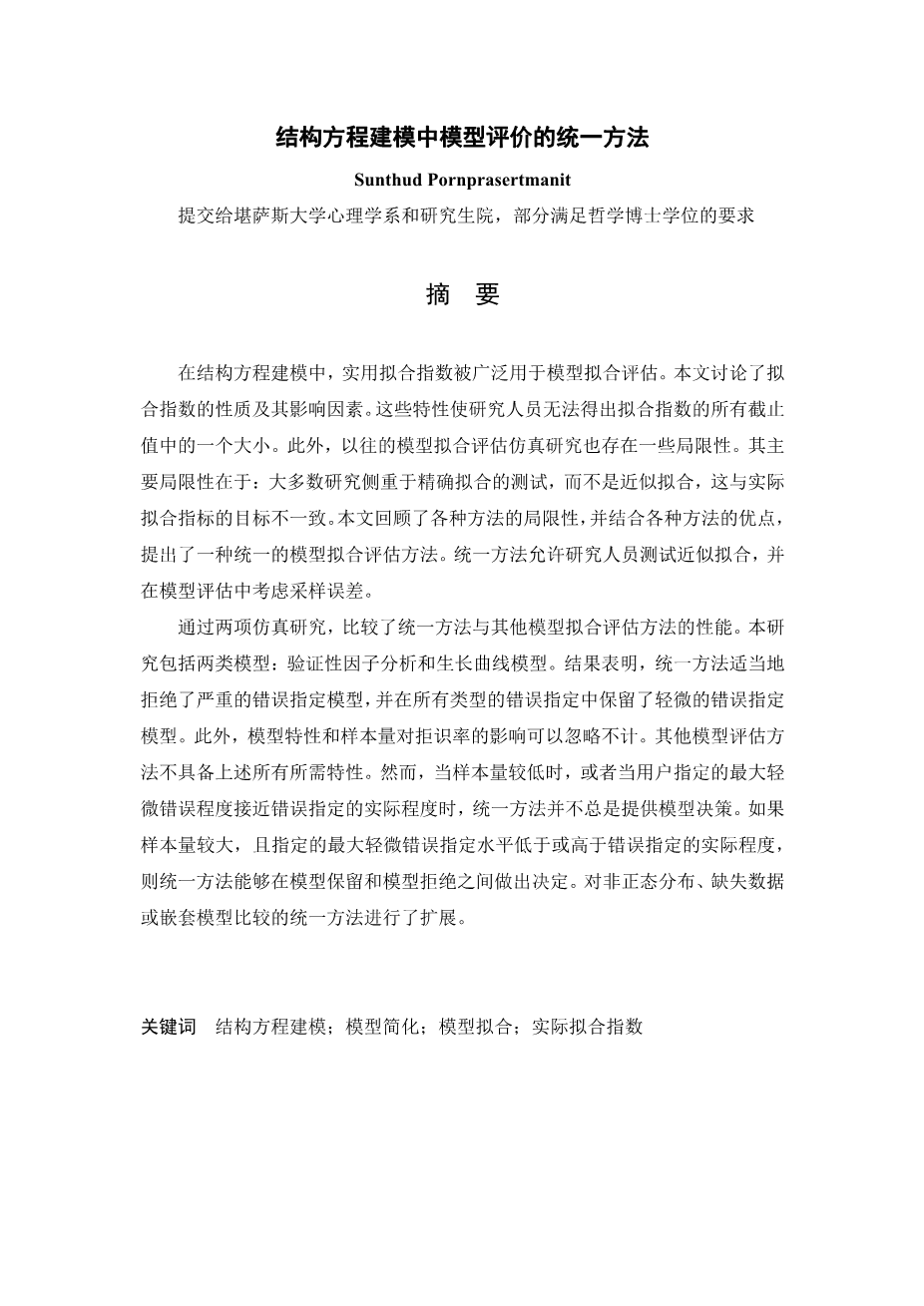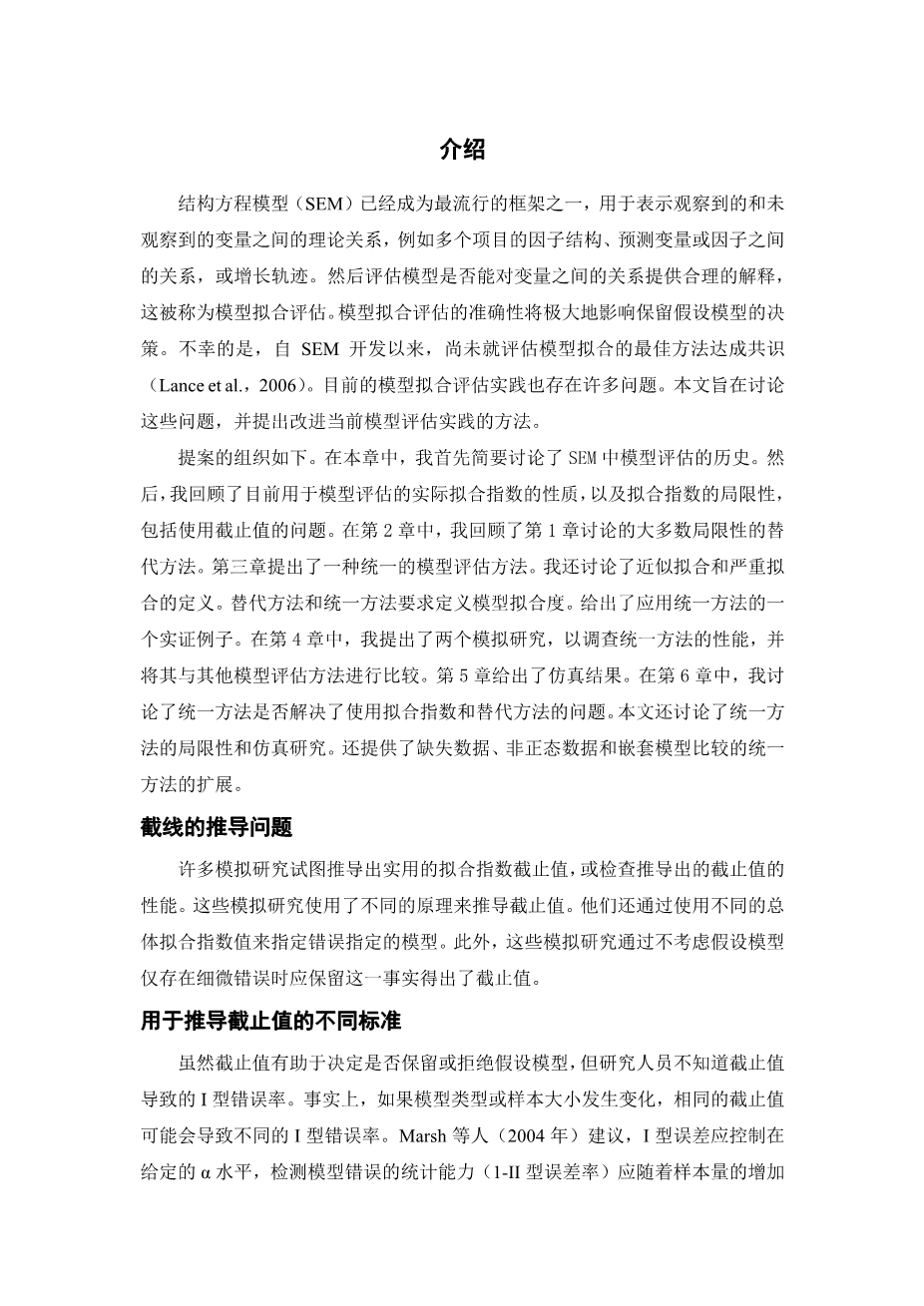附录Y 外文原文
The Unified Approach for Model Evaluation in Structural Equation Modeling
By Sunthud Pornprasertmanit Submitted to the Department of Psychology and the Graduate Faculty of the University of Kansas in partial fulfillment of the requirements for the degree of Doctor of Philosophy
Abstract
Practical fit indices have been widely used for model fit evaluation in Structural Equation Modeling. This dissertation discusses the properties of the fit indices including their influencing factors. These properties prevent researchers from deriving one-sizefit-all cutoffs for the fit indices. In addition, the past simulation studies on model fit evaluation have several limitations. The major limitation is that most studies have focused on test of exact fit rather than approximate fit which is not consistent with the goal of practical fit indices. This dissertation reviews alternative approaches to account for the limitations and proposes a unified method for model fit evaluation combining the advantages of the alternative approaches. The unified approach allows researchers to test approximate fit and take into account sampling error in model evaluation.
Two simulation studies are conducted to investigate the performance of the unified approach comparing to the other model fit evaluation methods. Two types of models are included in this study: confirmatory factor analysis and growth curve models. The results show that the unified approach appropriately rejects severely misspecified models and retains trivially misspecified models across all types of misspecification. Furthermore, the rejection rates are negligibly influenced by model characteristics and sample size. The other model evaluation methods do not have all of the desired properties described above. The unified approach, however, does not always provide model decision when sample size is low or when the level of maximal trivial misspecification specified by users is close to the actual degree of misspecification. If sample size is high and the level of specified maximal trivial misspecification is either lower or higher than the actual degree of misspecification, the unified approach is able to decide between model retention and model rejection. The extensions of the unified approach for nonnormal distribution, missing data, or nested model comparison are provided.
Keywords: structural equation modeling, model parsimony, model fit, practical fit indices.
Introduction
Structural equation modeling (SEM) has been one of the most popular frameworks to represent theoretical relations among observed and unobserved variables, such as factor structures underlying multiple items, predicting relationships among variables or factors, or growth trajectories. The models are then evaluated regarding whether they provide a plausible explanation of the relationships among the variables, which is referred to as model fit evaluation. The accuracy of model fit evaluation would highly influence the decision of retaining a hypothesized model. Unfortunately, since SEM was developed, no consensus has been reached in terms of the best way to evaluate model fit (Lance et al., 2006). The current practice of model fit evaluation also has many problems. This dissertation aims to discuss these problems and propose ways to improve the current practices of model evaluation.
The organization of the proposal as follows. In this chapter, I start with a brief discussion of the history of model evaluation in SEM. I then review the properties of practical fit indices that are currently used in model evaluation and the limitations of the fit indices including the problems of using cutoffs. In Chapter 2, I review alternative methods that account for most of the limitations discussed in Chapter 1. In Chapter 3, a unified approach for model evaluation is proposed. I also discuss how approximate fit and severe fit are defined. The definitions of the degrees of model fit are required by the alternative methods and the unified approach. An empirical 1example of applying the unified approach is provided. In Chapter 4, I propose two simulation studies for investigating the performance of the unified approach and comparing it with the other model evaluation approaches. In Chapter 5, the simulation results are provided. In Chapter 6, I discuss whether the unified approach solve the problems of the use of fit indices and the alternative methods. I also discuss the limitations of the unified approach and the simulation studies in this dissertation. The extensions of the unified approach for missing data, nonnormal data, and nested model comparison are also provided.
The Problems of the Derivation of the Cutoffs
Many simulation studies tried to derive the practical fit indices cutoffs or examine the performance of the derived cutoffs. These simulation studies used different principles to derive cutoffs. They also specified misspecified models by using different values of population fit indices. In addition, those simulation studies derived cutoffs by not considering the fact that the hypothesized models should be retained if they are only trivially misspecified.
Different Criteria Used for Deriving Cutoffs
Although the cutoffs facilitate decisions regarding whether to retain or reject hypothesized models, researchers do not know the Type I error rates resulted from the cutoffs. In fact, the same cutoffs can lead to different Type I error rates if model type or sample size changes. Marsh et al. (2004) suggested that Type I error should be controlled to a given alpha level and the statistical power (1- Type II error rate) to detect model misspecifications shou
剩余内容已隐藏,支付完成后下载完整资料
英语译文共 6 页,剩余内容已隐藏,支付完成后下载完整资料
资料编号:[588817],资料为PDF文档或Word文档,PDF文档可免费转换为Word
课题毕业论文、外文翻译、任务书、文献综述、开题报告、程序设计、图纸设计等资料可联系客服协助查找。




